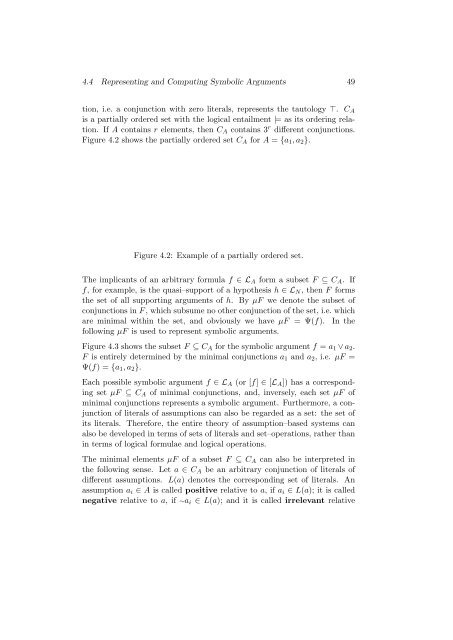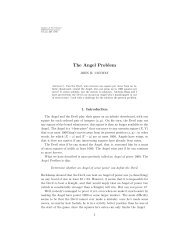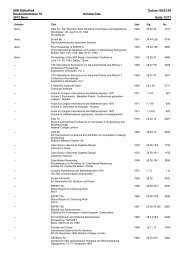Propositional Argumentation Systems and Symbolic Evidence Theory
Propositional Argumentation Systems and Symbolic Evidence Theory
Propositional Argumentation Systems and Symbolic Evidence Theory
Create successful ePaper yourself
Turn your PDF publications into a flip-book with our unique Google optimized e-Paper software.
4.4 Representing <strong>and</strong> Computing <strong>Symbolic</strong> Arguments 49<br />
tion, i.e. a conjunction with zero literals, represents the tautology ⊤. C A<br />
is a partially ordered set with the logical entailment |= as its ordering relation.<br />
If A contains r elements, then C A contains 3 r different conjunctions.<br />
Figure 4.2 shows the partially ordered set C A for A = {a 1 , a 2 }.<br />
Figure 4.2: Example of a partially ordered set.<br />
The implicants of an arbitrary formula f ∈ L A form a subset F ⊆ C A . If<br />
f, for example, is the quasi–support of a hypothesis h ∈ L N , then F forms<br />
the set of all supporting arguments of h. By µF we denote the subset of<br />
conjunctions in F , which subsume no other conjunction of the set, i.e. which<br />
are minimal within the set, <strong>and</strong> obviously we have µF = Ψ(f). In the<br />
following µF is used to represent symbolic arguments.<br />
Figure 4.3 shows the subset F ⊆ C A for the symbolic argument f = a 1 ∨ a 2 .<br />
F is entirely determined by the minimal conjunctions a 1 <strong>and</strong> a 2 , i.e. µF =<br />
Ψ(f) = {a 1 , a 2 }.<br />
Each possible symbolic argument f ∈ L A (or [f] ∈ [L A ]) has a corresponding<br />
set µF ⊆ C A of minimal conjunctions, <strong>and</strong>, inversely, each set µF of<br />
minimal conjunctions represents a symbolic argument. Furthermore, a conjunction<br />
of literals of assumptions can also be regarded as a set: the set of<br />
its literals. Therefore, the entire theory of assumption–based systems can<br />
also be developed in terms of sets of literals <strong>and</strong> set–operations, rather than<br />
in terms of logical formulae <strong>and</strong> logical operations.<br />
The minimal elements µF of a subset F ⊆ C A can also be interpreted in<br />
the following sense. Let a ∈ C A be an arbitrary conjunction of literals of<br />
different assumptions. L(a) denotes the corresponding set of literals. An<br />
assumption a i ∈ A is called positive relative to a, if a i ∈ L(a); it is called<br />
negative relative to a, if ∼a i ∈ L(a); <strong>and</strong> it is called irrelevant relative








